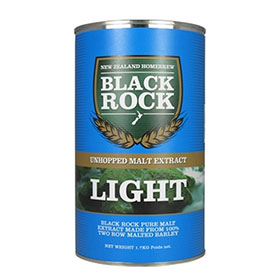Extract Brewing
 How to get started with extract brewing
How to get started with extract brewing
Now that you've made a few good batches of beer from a pre-hopped homebrew kit, it's time to expand your beer brewing skills. The next step up is extract brewing using malt extract, which gives you a whole heap more control over your final brew for just a little bit more effort.
Okay so what exactly is malt extract?
In beer brewing, malting is where the barley is soaked so it germinates. When this happens, the enzymes in the grain start breaking the starches down in to sugars to feed the plant. And those sugars are what you, the brewer, are after.
The germinated barley gets dried and then it's soaked again in water to reactivate the enzymes and they finish breaking down the starches. From that you get wort. The wort's then concentrated, normally by vacuum rather than heat so the sugars don't caramelise. The result is your malt extract - it looks like golden syrup in its liquid form, but you can buy it dried as well.
Malt extract comes in all sorts of different flavours, depending on the grains. Experiment! Just watch out - malt extract is unhopped and is not to be confused with the hopped extract kits you can buy.
Why use malt extract in your home brew?
Moving into extract brewing is a great way to start customising your home brew beer without having to buy extra equipment. You skip the mashing stage, and go straight to boiling and fermenting. You can still add any hops and grains to your beer-loving heart's desire, and you can choose your favourite malt extract too. It's just quicker, easier, and there's less equipment.
What you'll need to brew with malt extract
Since extract brewing is a progression from kit brewing, you should already have most of the things you'll need, including:
- a fermenter with a lid
- a mixing spoon
- a tube and bottling valve
- a trial jar measuring flask
- a hydrometer
- a thermometer
And bottles, lots of bottles. If you're totally new to the homebrew game, you can get all this equipment at once in a starter kit.
But for extract brewing, you'll also need a large brewing pot for making your own wort.
How to use malt extract in home brew (and steeping grains)
With all that out of the way, let's move on to the fun part.
In its most basic form, extract brewing involves dissolving your chosen malt extract in about eight litres of hot water to give you wort. In some cases you'll need to add sugar or dextrose too, depending on the recipe. You can play around with this, but a good rule of thumb is to not make more than 10 percent of your recipe sugar.
Bring to the boil, add your favourite hops and continue to boil the wort for as long as your recipe specifies to develop the bitterness. You'll need a vigorous boil but try not to let too much liquid boil off - it'll darken your wort, caramelise the sugars, and the hops won't do their job. Then top up to 23L with cold water, cool your wort as fast as you can, and move on to fermenting as you normally would.
Sound easy? It is. So now's a good time to have a crack at adding grains for colour, flavour and body.
You can start by steeping grains before you add your malt extract. Put your grains in a steeping bag and let it sit in your pot of water at about 70 degrees for half an hour. Then pull out the bag, crack open your malt extract and get brewing.
Be careful with your choice of grains. Some grains, usually the paler malts, have to be mashed to get any flavour from them. Good ones to try steeping are black malt, chocolate malt, and roasted barley.
Moving on to partial mash
Partial mash is an intermediate step between extract brewing and all-grain brewing. With partial mash brewing, you're mashing grains like in all-grain brewing, but also adding malt extract.
It's not so different from steeping grains, except that because you can use any grains, not just ones that don't need mashing, you can pick any flavours you want.
For partial mash, you'll need to buy a mash tun, or you can make your own. You'll also need crushed grains - ask your supplier to do the crushing for you.
Put your grains in your mash tun or brewpot with 1.3L of water per 500g of grain, and hold it at about 65 degrees for about an hour. Then run hot water through it, filtering so you end up with wort. Then you can add your malt extract and proceed.
Finding recipes
If all this business about choosing malt extracts and grains and hops seems a bit daunting, don't panic. To start with, you could try a recipe kit. These are a great way to get started making homebrew with malt extract, because they come with all the ingredients you need, including instructions. Make a few of those, and you'll start to understand how it comes together and think about tweaks you want to make. Otherwise search around for a recipe that suits your style and give it a go. There are lots of recipes and resources on the internet.